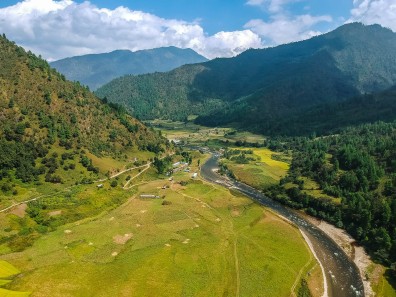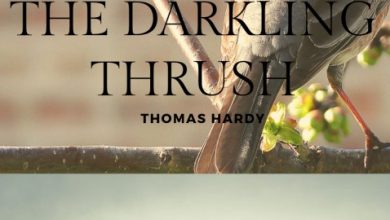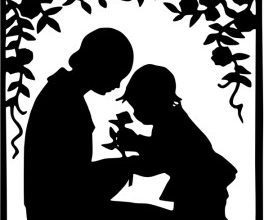
Small Towns and The River is a poem written by Mamang Dai and published in 2004 in her collection titled River Poems. It is a seven-stanza poem written in first-person. The poem focuses on elements of life and death through the lens of a small town by the river.
Small Towns and the River was written by Mamang Dai and published in 2004 in her collection called River Poems. It is a seven-stanza poem written in first-person. The poem focuses on elements of life and death through the lens of a small town by the river.
Small Towns and The River | Summary
The poet begins by saying that small towns always remind her of death. She then thinks back to her own hometown- surrounded by trees, with memories of the wind in the gorge and the dust flying about. It looks the same no matter what the season. The poet then mentions that someone did die recently, and the town gathered to sob quietly at the flowers decorating the funeral. Life and death are unavoidable, people come and go. It is only the funeral rituals which remain constant.
The focus then shifts onto a river– presumably the river located in the poet’s hometown. The river has a soul of its own. It gushes through the land in the summer, like an outpouring of grief. The poet thinks that sometimes, the river may long for more, holding its breath as it looks for a new land full of fish and stars. The river rips through the town and sees everything- the drops or rain, the dry Earth and even the mountaintops. The water survives it all, and hence the river knows its own immortality.
A sanctuary of photos capturing all the happy moments is what marks the joy of childhood. Those in small towns live in nervousness and anxiety for what is to come. When someone dies, they are buried pointing West. This way, when the soul arises, it can walk towards the East as the sun rises. Within the body like the coolness of bamboo, the sunlight restores the peace of the soul, and this is when life is of the greatest importance. Everyone in the small town by the river wants to walk with God.
Small Towns And The River | Analysis
Small Towns and Rivers by Mamang Dai is a short, metaphorical depiction of life and death, and spirituality. Dai expresses these elements through the lens of nature– specifically, a small town by the river. The poem does not have a fixed rhyme scheme, and is irregular in rhythm. The stanzas are also uneven. This, along with the balance between descriptive narration and the poet’s own memories, adds to the personalization of the poem. Dai is from Arunachal Pradesh, and Small Towns and Rivers is written in reflection of her own native place. This context makes it even easier to visualize the described location, and further, the unity of the town.
Dai employs metaphors, personifications, imagery, similes, and most importantly, symbolism. These aspects of nature are used as symbols to the theme of life and immortality, and the various descriptions create a relaxed atmosphere despite the depth of the topic. This was a clever comparison by Dai, as by painting a calming image of nature, the theme of spirituality comes across in equal clarity and peace. The main themes of this poem are the cycle of birth and death, nature, spirituality, the afterlife, and the idea of immortality.
Small Towns And Rivers | Analysis, Lines 1 – 6
“Small towns always remind me of death.
My hometown lies calmly amidst the trees,
it is always the same,
in summer or winter,
with the dust flying,
or the wind howling down the gorge.”
Dai begins the poem by establishing the context. The first line, “Small towns always remind me of death,” makes it clear that death is an important theme, and the small town will be a constant reference. She then sets the scene through descriptive lines, which forms a slightly gloomy yet serene aura around the town. The line “it is always the same” is a reference to the element of constancy, which is an important contrast– after all, life and death is an ever-moving cycle. This town, on the other hand, is described to remain untouched among the changing world. Dai also expresses the mood of the town using sound- “the wind howling down the gorge.” Such a line alludes to feelings of loneliness, which points towards the isolation of the town among the trees. It is also interesting to note that the trees are known for being living, breathing species, yet they surround a town which reminds the poet of death. This duality symbolises life and death– nature symbolises life, while the town symbolises death.
Small Towns and Rivers | Analysis, Lines 7-11
“Just the other day someone died.
In the dreadful silence we wept
looking at the sad wreath of tuberoses.
Life and death, life and death,
only the rituals are permanent.”
In the second stanza, an incident from the narrator’s personal life is presented. This draws the readers closer to the poem, and the very town itself. The line, “In the dreadful silence we wept” implies the closeness of the people in the town. When one person died, the entire town mourned the loss together. This stanza introduces the idea of immortality, as well- but what is immortal is not the person, only the rituals. “Life and death, life and death” is written in immediate repetition to highlight its cyclic nature. It is constantly changing- millions of people are born and then they die, and we never know when or where or how it may happen. But if one thing is permanent, it is the rituals, for they are followed throughout generations. Life and death are natural processes; hence they are always changing. However rituals, which are man-made processes, remain the same. This is similar to the way the town, a man-made structure, remains the same throughout the different seasons as mentioned in the previous stanza.
Small Towns and Rivers | Analysis, 12-16
“The river has a soul.
In the summer it cuts through the land
like a torrent of grief. Sometimes,
sometimes, I think it holds its breath
seeking a land of fish and stars”
In the third stanza, we see the theme of spirituality and life. The river is personified, drawing off the fact that nature is indeed living. Most importantly, this is a swift change from the previous two stanzas, which dealt with death. “Sometimes, sometimes, I think it holds its breath seeking a land of fish and stars” is an imagery. It is as though the river is a person on a journey, looking for something, and that is why it stretches on for so long with no signs of stopping. The river is described to be “cutting through the land; seeking a land of fish and stars.” We can see all three elements of the Earth- land, underwater and the sky- implied here. This may suggest the great and unavoidable power that nature has over everything, no matter which part of the world it may be. The “torrent of grief” in summer points towards the possibility of drought, or the water scarcity that comes with the overwhelming heat.
Small Towns And Rivers | Analysis, Lines 17 – 22
“The river has a soul.
It knows, stretching past the town,
from the first drop of rain to dry earth
and mist on the mountaintops,
the river knows
the immortality of water.”
In the fourth stanza, “The river has a soul.” is repeated. A refrain is used to highlight the importance of the line. Dai emphasizes the fact that the river flows throughout the land, beyond the small town. The river feels the first drops of rain touch its surface, and flows up the mountain till it reaches the mist. Throughout all of this, it does not dry out- the river knows its own immortality. With this line, we feel the permanence of the river. However, while its presence is permanent, it is always physically moving, travelling the world and gushing forward. This is the difference between the river’s permanence and the town’s- the town is a sedentary constant, while the river is a moving one. We are also introduced to one type of immortality: the undying nature.
Small Towns and Rivers | Analysis, Lines 23-30
“A shrine of happy pictures
marks the days of childhood.
Small towns grow with anxiety
for the future.
The dead are placed pointing west.
When the soul rises
it will walk into the golden east,
into the house of the sun.”
In the fifth stanza, the focus shifts from nature back to the narrator. “A shrine of happy pictures” refers to the collection of captured memories from the childhood days. Childhood is said to be the most free, happy and carefree time of one’s life- there are not as many worries, and there is a purity of the soul. Children are not yet exposed to the harsh realities of life, nor do they fear the unknown- with their childlike innocence, they are more curious and excited. Childhood represents the joy of life. This tone is in contrast to the third and fourth lines of the stanza, which shifts to anxiousness and restlessness. Within these four lines, we see the growth of a person through the life-cycle. The carefree childish souls of the town grow into ones which understand the ways of the world. And when they do, the town together becomes more worried for the future. Nobody knows what comes after death, and this fear seems to cause a high tension.
There is then a mention of the town’s practice when one passes away. We see the theme of spirituality as Dai talks about the soul and its life after the body’s death. The line “it will walk into the golden east, into the house of the sun.” refers to the sun rising in the east. Hence, when one dies, they are placed by the west so that their soul can walk towards the sun as it rises. The rising sun represents a new day. Therefore, this symbolises new beginnings and rebirth. The poem alludes to the rebirth of the soul once it rises out of the body it was in. This also suggests a theme of immortality, but a different kind from the river’s– this is the immortality of the human soul, rather than of nature.
Small Towns and Rivers | Analysis, Lines 31-33
“In the cool bamboo,
restored in sunlight,
life matters, like this.”
Here, the sunlight is what warms the “cool bamboo.” The bamboo symbolises the body, while the “sunlight” symbolises life. The sunlight restores the bamboo as life restores the body. Here, life is the soul- only with the entrance of a soul into the body can a new life be created. The soul is to the body what sunlight is to nature. Throughout the poem, the anxiousness of death and the thought of immortality has been reiterated several times. In the last line of this stanza, however, we see the acknowledgement of the importance of life for the first time- a positive take on the life-and-death cycle. The tone of this line is cleverly placed at the end of the poem, creating a balance with the restless, gloomy nature of the topic of death which has been previously talked about.
Small Towns and Rivers | Analysis, Lines 34-35
“In small towns by the river
we all want to walk with the gods.”
In the final stanza, Dai goes back to her roots, quite literally- she returns to the first stanza, which is a homage to her native town. The plural- “small towns by the river”- suggests that she is referring to other such towns in general, as well. She acknowledges that everybody from these towns have the aim to walk with the gods, which means that they all wish to live peacefully and happily in the afterlife. This is the final element of immortality in the poem- rather than the soul entering a new body, it travels to the heavens and walks with the Gods. This provides a rather hopeful conclusion to the poem. Life and death is a continuous cycle in the midst of nature, but the end may not be as terrifying as one believes. For the soul will replenish in the sunlight and find a new source of life, whether it is nature, a body on the earth, or the afterlife.
small towns and rivers summary




Thanks a lot for your great effort to share knowledge among us. The piece of writing which you have uploaded is really appreciable.